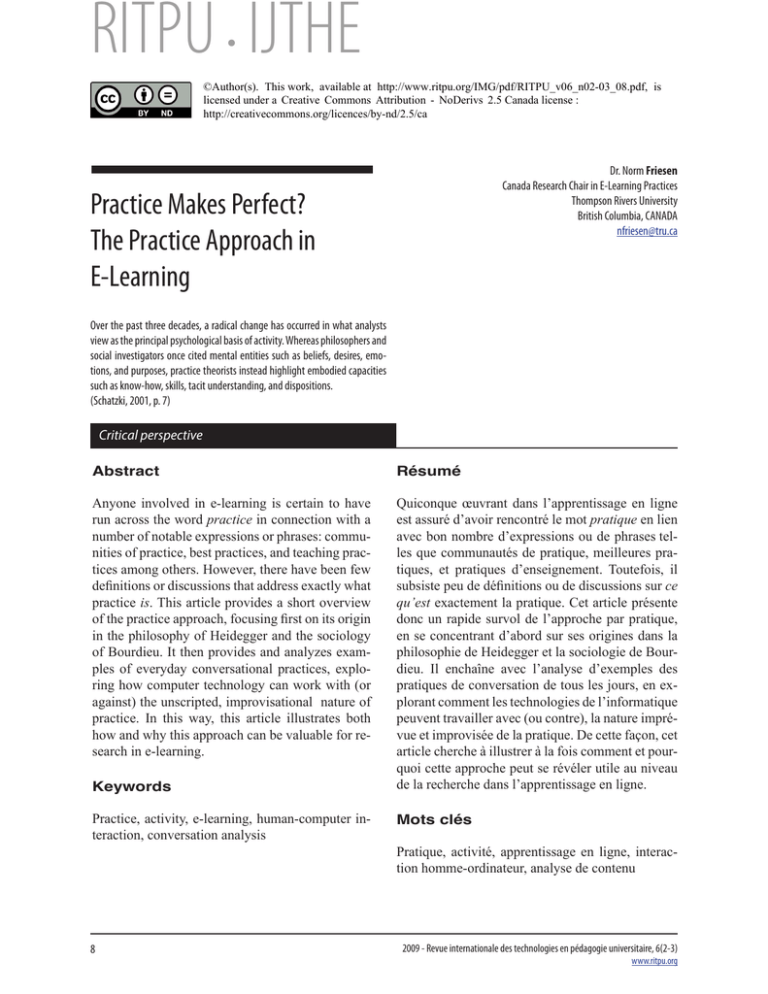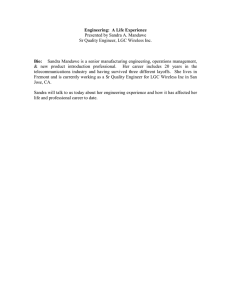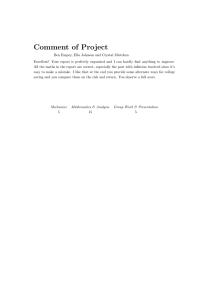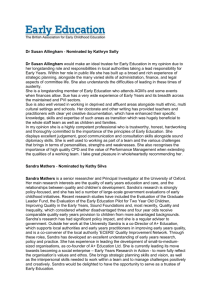RITPU IJTHE •
advertisement

RITPU • IJTHE ©Author(s). This work, available at http://www.ritpu.org/IMG/pdf/RITPU_v06_n02-03_08.pdf, is licensed under a Creative Commons Attribution - NoDerivs 2.5 Canada license : http://creativecommons.org/licences/by-nd/2.5/ca Dr. Norm Friesen Canada Research Chair in E-Learning Practices Thompson Rivers University British Columbia, CANADA nfriesen@tru.ca Practice Makes Perfect? The Practice Approach in E-Learning Over the past three decades, a radical change has occurred in what analysts view as the principal psychological basis of activity. Whereas philosophers and social investigators once cited mental entities such as beliefs, desires, emotions, and purposes, practice theorists instead highlight embodied capacities such as know-how, skills, tacit understanding, and dispositions. (Schatzki, 2001, p. 7) Critical perspective Abstract Résumé Anyone involved in e-learning is certain to have run across the word practice in connection with a number of notable expressions or phrases: communities of practice, best practices, and teaching practices among others. However, there have been few definitions or discussions that address exactly what practice is. This article provides a short overview of the practice approach, focusing first on its origin in the philosophy of Heidegger and the sociology of Bourdieu. It then provides and analyzes examples of everyday conversational practices, exploring how computer technology can work with (or against) the unscripted, improvisational nature of practice. In this way, this article illustrates both how and why this approach can be valuable for research in e-learning. Quiconque œuvrant dans l’apprentissage en ligne est assuré d’avoir rencontré le mot pratique en lien avec bon nombre d’expressions ou de phrases telles que communautés de pratique, meilleures pratiques, et pratiques d’enseignement. Toutefois, il subsiste peu de définitions ou de discussions sur ce qu’est exactement la pratique. Cet article présente donc un rapide survol de l’approche par pratique, en se concentrant d’abord sur ses origines dans la philosophie de Heidegger et la sociologie de Bourdieu. Il enchaîne avec l’analyse d’exemples des pratiques de conversation de tous les jours, en explorant comment les technologies de l’informatique peuvent travailler avec (ou contre), la nature imprévue et improvisée de la pratique. De cette façon, cet article cherche à illustrer à la fois comment et pourquoi cette approche peut se révéler utile au niveau de la recherche dans l’apprentissage en ligne. Keywords Practice, activity, e-learning, human-computer interaction, conversation analysis Mots clés Pratique, activité, apprentissage en ligne, interaction homme-ordinateur, analyse de contenu 2009 - Revue internationale des technologies en pédagogie universitaire, 6(2-3) www.ritpu.org IJTHE • RITPU Anyone involved in e-learning is certain to have run across the word practice in connection with a number of notable expressions or phrases: communities of practice, best practices, and teaching practices among others. However, there have been few definitions or discussions that address exactly what practice is. This is not helped by the fact that the word practice has multiple but closely interrelated everyday meanings. It is obviously something that we do, as members of a professional or other type of group (think of medical, legal, or religious practices), and it is something that improves through repetition or is tied to habit (think of practicing yoga or politeness). Finally, practice is often defined as being the opposite of mere words or theory (“practice what you preach”). In any case, despite definitional differences, practice is what we do—whether a narrow set of actions performed repeatedly or a more wide-ranging and complex array of activities. Yet it is also much more (and less) than this. This article provides a short overview of the practice approach followed by examples to illustrate both how and why this approach can be valuable for research. To understand the relevance of the term practice for e-learning, we examine its use and meaning in various publications and specializations. The term community of practice originates in the works of Jean Lave and Etienne Wenger, who wrote about practice in books such as Situated learning: Legitimate peripheral participation (Lave & Wenger, 1991) and Communities of practice: Learning, meaning, and identity (Wenger, 1998). Looking at the sources that Lave and Wenger used, it is fairly clear that their understanding of practice draws on the sociology and philosophy of Bourdieu and Heidegger. For these thinkers, practice was fundamental to knowledge, learning, and human reality. Indeed, for them, practice was centrally constitutive of what it is to be human. For example, Heidegger has been interpreted as saying that our being is manifest in terms of the “intelligibility of everyday background practices” (Dreyfus, 1991, p. 10, italics in original). In a number of books devoted to 2009 - International Journal of Technologies in Higher Education, 6(2-3) www.ijthe.org the subject of practice, Bourdieu describes it rather enigmatically as having “a logic which is not that of the logician” (Bourdieu, 1980/1992, p. 86). He also emphasizes that human practices and activities are reducible neither to rational criteria, nor hidden systems, nor schematic structures, and that practices are instead “organized around shared practical understandings” (Schatzki, 2000, p. 11). A more general discussion of the notion of practice and its implications is found in a book titled The Practice Turn: ‘Practice’ brings into view activities which are situated, corporeal, and shaped by habits without reflection. This notion has been extraordinarily successful and has now been extended to cover every sort of human activity. (Thévenot, 2000, p. 64) Whether explicitly recognized or not, e-learning has not escaped this practice turn, as the commonly used terms such as activity and situated in its vocabulary attest. Related areas such as human–computer interaction and software design have followed suit (e.g., Dourish, 2001; Levina & Vaart, 2005; Schultze, 1998), and prefigure some implications for e-learning. One of the most important of these implications is that the practice perspective radically changes the way we think about our involvement with technologies. Perhaps the simplest way of putting this is that the reputed similarities between learner and technology, between carbon- and silicon-based computation, are no longer so important, but rather the differences. Unlike humans, the intelligibility of the actions, or rather, the operations of computers, are neither situated nor embodied. These computational operations are the same on a desktop in Toronto as they are on a laptop in Turin. Any intelligence or intelligibility that computers may manifest has nothing to do with background practice, that is, common sense, context, or everyday understanding. Instead, their operation is entirely reducible to system or structure: it can only follow a type of recipe and a logician’s logic. As research into practice has RITPU • IJTHE long shown, humans do not perform even simple actions such as turning on a light (e.g., Suchman, 2006), driving a car (Dreyfus & Dreyfus, 1986), or figuring out the bill at the grocery store (Lave, 1988) as if they were carbon-based computers, as if following a logician’s logic. In this sense, practice research offers an alternative to the schemas, structures, and mental models of cognitivism. Of course, computers have become increasingly complex, ubiquitous, and embedded in our everyday activities. At the same time, researchers and developers in human–computer interaction have had to recognize the centrality of the situated, the corporeal, and the habitual in human activity, and have tried to adapt the rule-bound operation of the computer to this centrality. They have argued that practices create a kind of place, a habitus (to use Bourdieu’s term), into which technology is adapted—rather than the other way around: The important point to recognize here is that these practices emerge not from the designers of the system, but from the actions of its users. This means two things; first, that true places emerge only when really occupied day-to-day, not in demonstrations or experiments that last a few hours; and second, that place can’t be designed, only designed for. (Dourish, 2001, p. 91; emphasis in the original) How is it possible to study and learn more about these types of undesignable places? How can the design of these places of practice be changed to more appropriate designs for? Methodologies associated with practice research address such questions by enabling the study—in situ and often over extended periods of time—of the everyday, the non-scripted, the embodied, and the habitual. Ethnomethodological and ethnographic methods, for example, can be used to identify and study phenomena (e.g., patterns, genres, and local informational customs and habits) through which the contours of these loci are shaped (e.g., Kwaśnik & Crowston, 2005). 10 Moreover, the history of technology as the story of technology in the making—rather than the story of technologically-driven trends and triumphs—offers another methodological avenue for this kind of research (e.g., Agalianos, Whitty, & Noss, 2006; Lehman, 2004). Finally, conversational and discursive analyses have brought researchers into close contact with situated and habitual communicative practices, which are of great interest in e-learning research (e.g., Mazur, 2003). Often escaping our attention by virtue of their apparent obviousness, these practices can reveal much about learning processes, the pragmatics of technologies in educational situations (e.g., Friesen, 2007), and the mutually shaping communicative practices and technologies (e.g., Hutchby, 2001). In fact, an entire psychology—called discursive psychology—has emerged out of this type of understanding and analysis. Consider these two conversations, one between Fred and Alice and the other between Sandra and Ella: Fred – Alice Alice: Hello? Fred: Hello, Alice? Alice: Hi, Fred. Fred: Hi, what are you doing? Alice: Nothing, what’s up? Fred: How about if I come over for a while? Alice: Great, I’d love to see you. Fred: Okay, I have a paper that needs typing. Ella - Sandra Ella: Hello, my name is Ella. Nice to meet you. Please tell me what name I should call you. Sandra: People call me Sandra. Ella: Okay, I will call you Sandra. Sandra: Good =] Ella: Really Sandra, but there is more we need to discuss, right? Sandra: Sure. Ella: Okay with me also, Sandra. Sandra: Okay. Ella: Thank you for being agreeable. Sandra: np Ella: “No problem” is usually good news, but maybe I need to consider what you say carefully. 2009 - Revue internationale des technologies en pédagogie universitaire, 6(2-3) www.ritpu.org IJTHE • RITPU Which exchange do you think involves a computer as a conversational partner? What technology might have been used as a medium in either conversation? And what might be the basis for your answers or guesses to these questions? The signs and hints are subtle but telling. Researchers in discursive practices and ethnomethodology refer to what is called the anchor point in conversation. This point identifies the juncture at which the conversers get to the point or business of the conversation. The presence or absence of this point in the above conversation is decisive. Ella and Sandra simply never get down to business. The business in Fred and Alice’s conversation, on the other hand, is all too readily apparent (Fred seems to need a typist). Another telling sign is what analysts call the gatekeeping function. Fred and Alice first check each other’s identity and availability (“Hi, Fred […] what are you doing?”), presumably for both the call and possibly a face-toface meeting. There is no equivalent gatekeeping in the Ella–Sandra exchange, however. Ella, as you may have suspected, is a computer: a chatbot (see: ellaz.com). Interestingly, it may not be a lack of resources—lack of computational power or formalized knowledge—that keeps Ella from conversational involvement. Instead, it may be Ella’s utter removal from such a lack—from the limitations of time, place, and attention that we are always negotiating—that identifies her as a computer. These common conversational functions take different forms with different technologies. Fred and Alice, as you probably guessed, are using the phone, and Ella and Sandra are connecting via a form of instant messaging. Discursive and practice researchers look at events in which apparently nothing happens. On a deeper level, however, achievements are actually “arrived at out of a welter of possibilities for preemptive moves or claims, rather than a mechanical or automatic playings out of pre-scripted routines” (Schegloff, 1986, p. 119). 2009 - International Journal of Technologies in Higher Education, 6(2-3) www.ijthe.org Activities that are so obvious that we do not even realize that we are doing them—saying hello over the phone—illustrate what is meant by everyday background practices. In the research on practice, these activities constitute our being, our humanity. And the importance of this element is reinforced by the computer’s inability to pass as a conversational partner. Because these essentially human practices are not rule-bound, it is only possible to design for these activities—giving users the freedom to control or improvise in these activities—rather than develop a design of these actions and engagements. The above-presented example shows that studying a practice involves not only different methods, research designs, and ways of thinking, it also has new and exciting implications for research and the practice itself. First, this type of research emphasizes the agency of end-users, students, and teachers, explicitly recognizing their active role in creating their own practice through the use of technologies. As mentioned above, technologies and instructional designs are seen as supporting these practices—rather than these practices being designed in advance as prescribed forms of learning or interaction. The practice approach also valorizes the education site. It does not view the classroom as a necessarily compromised version of the more rigorous environment of the lab. It looks to the everyday, the banal, the unique teachable moment for insight, rather than seeking universals, which have proven notoriously elusive. Finally, by offering an alternative to an uncritical affirmation of technology and its inevitability, these methodologies offer the potential for rigorous and systematic research that can be constructive as well as critical. 11 RITPU • IJTHE References Agalianos, A., Whitty, G., & Noss, R. (2006). The social shaping of Logo. Social Studies of Science, 36(2), 241–267. Bourdieu, P. (1992). The logic of practice (R. Nice, Transl.). Stanford, CA: Stanford University Press. Dourish, P. (2001). Where the action is: The foundations of embodied interaction. Cambridge, MA: MIT Press. Dreyfus, H. (1991). Being in the world: A commentary on Heidegger’s being and time. Cambridge, MA: MIT Press. Dreyfus, H., & Dreyfus, S. (1986). Mind over machine: The power of human intuition and expertise in the era of the computer. New York, NY: Free Press. Friesen, N. (2007). Discursive psychology and educational technology: Beyond the cognitive revolution. Retrieved June 21, 2010 from the author’s website: http://learningspaces.org/n/ papers/DP_and_ET.doc Hutchby, I. (2001). Conversation and technology: From the telephone to the Internet. Cambridge, UK: Polity Press. Kwaśnik, B. H., & Crowston, K. (2005). Introduction to the special issue: Genres of digital documents. Information Technology & People, 18(2), 76-88. Lave, J. (1988). Cognition in practice: Mind, mathematics and culture in everyday life. Cambridge, UK: Cambridge University Press. Lave, J., & Wenger, E. (1991). Situated learning: Legitimate peripheral participation. Cambridge, UK: Cambridge University Press. Lehman, J. A. (2004, October). A social construction of technology (SCOT) model of the failure of Webbased distance delivery programs in traditional universities. Paper presented at the 2004 joint PRDLA and PNC Conference, Taipei, Taiwan. Retrieved June 21, 2010 from the author’s website: http://www.faculty.uaf.edu/ffjal/papers/ SCOT%20e-learning.pdf 12 Levina, N., & Vaast, E. (2005). Turning collaboration into transaction: A case of intranet use in boundaryspanning practices. In Proceedings of the 38th Hawaii International Conference on System Sciences (p. 245a). New York, NY: IEEE Computer Society. Mazur, J. M. (2003). Conversation analysis for educational technologists: Theoretical and methodological issues for researching the structures, processes, and meaning of on-line talk. In D. Jonassen (Ed.), Handbook of research for educational communications and technology: A project of the association for educational communications and technology (2nd ed) (pp. 1073-1098). Mahwah, NJ: Lawrence Erlbaum. Schatzki, T. (2001). Introduction: Practice theory. In T. Schatzki, K. D. Knorr Cetina & E. von Savigny (Eds.). The practice turn in contemporary theory (pp. 1-14). London, UK: Routledge. Schegloff, E. A. (1986). The routine as achievement. Human Studies, 9, 111-151. Schultze, U., Boland, R.J. Jr., Havey, L., & Karsten, H. (2001). Four perspectives for understanding work practices: Giddens, Bourdieu, Foucault, and narrative (panel session). In J. I. DeGross, R. Hirschheim & M. Newman (Eds.), Proceedings of the Nineteenth International Conference on Information Systems (pp. 407-409). Atlanta, GA: Association for Information Systems. Suchman, L. (2006). Human-machine reconfigurations: Plans and situated actions. Cambridge, UK: Cambridge University Press. Thévenot, L. (2001). Pragmatic regimes governing engagement with the world. In T. Schatzki, K. D. Knorr Cetina & E. von Savigny (Eds.). The practice turn in contemporary theory (pp. 56-73). London, UK: Routledge. Wenger, E. (1998). Communities of practice: Learning, meaning, and identity. Cambridge, UK: Cambridge University Press. 2009 - Revue internationale des technologies en pédagogie universitaire, 6(2-3) www.ritpu.org


